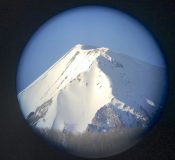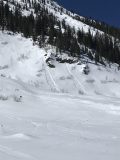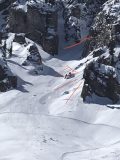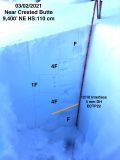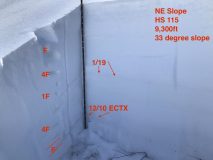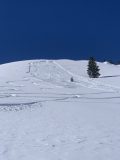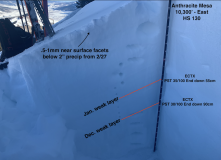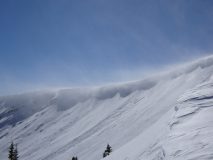Date of Observation: 02/26/2021
Name: Jack Caprio, Zach Kinler, Jared Berman
Zone: Northwest Mountains
Location: From Top of the World, we descended rock creek drainage to gothic campground
Aspect: North, North East, East, South East, South
Elevation: 9,600-11,600
Avalanches: Fresh wind slabs on a cross loaded alpine south aspect above Rustler Gulch (see photo).
An older, persistent slab avalanche on an east facing slope about 200 ft. above the east river valley bottom (see photo).
Weather: Westerly winds and overcast skies made for a cold sled ride in the morning. As the day went on, the clouds cleared and temps increased making for a very comfortable weather day.
Snowpack: We dug below treeline on a NE facing slope a couple hundred feet above the Gothic campground. We found a very stubborn persistent slab problem. At this pit site, the January interface sits 75 cm below the surface, with a large 1F hard slab resting on top. The 12/10 layer, which consists of large grained (6 mm chained) depth hoar, makes up the bottom 35 cms of the pack, and doesn’t seem to be showing any signs of improving. Snowpit tests did not produce any failures even after a couple aggressive swings from the shoulder after proper ECT tests (CTN, ECTX, ECTX). An aggressive shovel shear after our ECT tests did produce failure at the top of the 12/10 depth hoar layer. We did not receive any feedback from the snowpack such as cracking and collapsing while traveling in previously untraveled terrain.
The snow surface continues the near surface faceting process on shady aspects (currently .3-.5 mm NSF). On solar aspects, the surface consists of a 1-2 inch thick MF crust capping small grained facets. Everywhere we traveled above treeline (NE, E aspects), the snow surfaces were very beaten up due to recent winds, and hold perfect faceplanting conditions.
Photos:
-

-
Snowpack below treeline on NE aspect near Gothic Campground
-

-
Older persistent slab avalanche above Gothic Campground. Hard slab debris ran several hundred feet.
-
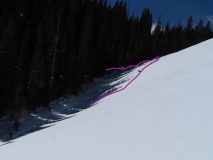
-
SE aspect near a shady creek bottom, older persistent slab avalanche just below 403 trail.
-
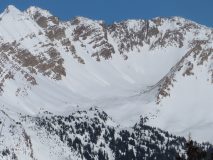
-
Fresh windslabs in crossloaded terrain features near Rustler Gulch





